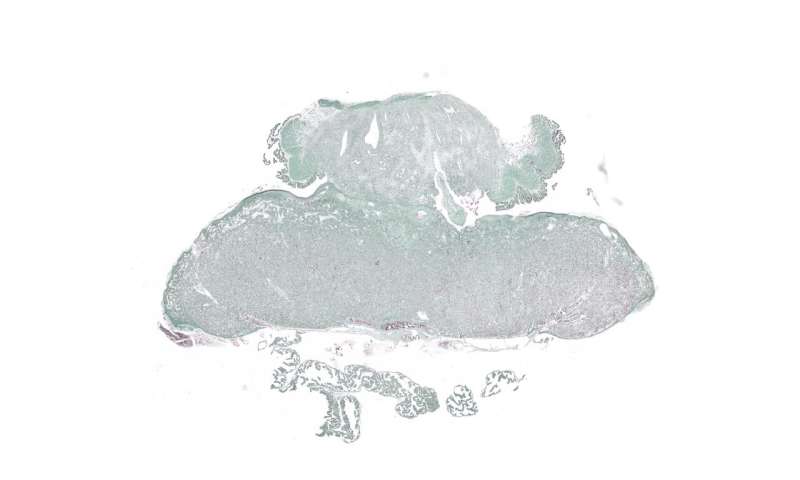

Preeclampsia usually begins after the 20th week of pregnancy. The affected women suddenly develop high blood pressure, they excrete increased amounts of protein in their urine (called proteinuria)—a sign that the small blood vessels in the kidneys are damaged. It can also cause life-threatening damage to the liver and bone marrow. Moreover, the unborn baby is not adequately nourished, which can interfere with the baby’s growth and development. About 5% of all pregnant women in Western countries suffer from some form of preeclampsia.
“Preeclampsia is the most common pregnancy-related disease that today in Germany still causes a significant number of deaths among women, and it is also the leading cause of premature births, with some births occurring between the 24th and 30th weeks of pregnancy,” says Dr. Nadine Haase from the Experimental and Clinical Research Center (ECRC). Haase is the lead author of a study on preeclampsia that is now being published in the Journal of Clinical Investigation. She is a member of the Hypertension-Mediated End-Organ Damage Lab, led by Professors Dominik Müller and Ralf Dechend, the latter of whom is the senior author of the paper.
The disease has previously been untreatable
There are not yet any medications for treating preeclampsia. “We know that the endogenous renin-angiotensin-aldosterone system (RAAS), which regulates blood pressure as well as water and electrolyte balance, is disrupted in women with the disease,” Haase says. “However, those agents already known to intervene in the RAAS system cannot be administered to pregnant women, because they could harm the unborn baby, especially impairing kidney development.” And other antihypertension drugs, such as methyldopa, have only a minimal effect on preeclampsia. “Often the only option is preterm delivery, and many of these premature babies don’t survive or have disabilities,” Haase says.
So together with colleagues from Berlin, Essen, Hamburg, and Jackson, Mississippi, as well as a team from the Cambridge, Massachusetts-based medical research firm Alnylam Pharmaceuticals, Haase began to search for more effective drugs to treat preeclampsia. The researchers wanted to find out if the small interfering RNA (siRNA) molecules developed by Alnylam could alleviate the symptoms of preeclampsia without harming the fetus. “The siRNA we are using slows the production of the hormone angiotensinogen (AGT) in the liver,” Haase explains. “AGT is a precursor of angiotensin. As a result, the siRNA acts on the RAAS system in regulatory manner.” Alnylam has already successfully employed this mechanism of action to treat other diseases in humans.

Two animal models of preeclampsia
Haase and her colleagues tested the siRNA on two animal models. In the first model, the team of researchers used female rats that had been genetically altered so that they produced human AGT. They crossed these animals with male rats that produce human renin. Such a procedure leads to hyperactivity of the RAAS system with corresponding symptoms of preeclampsia during the gestation of the female rats.
In the other model, which was developed in the United States and goes by the name of reduced uteroplacental perfusion (RUPP), clips that reduce blood flow in the placenta were applied to the gestating rats. This caused the rat fetuses to be undernourished. In addition, the maternal rats treated with the clip developed—as did the genetically altered animals—high blood pressure and proteinuria, albeit at a lower level. Two clinical biomarkers—PlGF and sFlt-1—that are used in the diagnosis of preeclampsia were also altered in the rats.
Lower blood pressure, larger fetuses
For the therapeutic experiment, the researchers injected siRNA under the skin of the rats. They had chemically altered the molecules so that they would only act on the liver—i.e., where the hormone AGT is produced. “As hoped, we observed a decrease in the symptoms of preeclampsia in the treated rats, and this was true for both models,” Haase says. “Their blood pressure fell and the proteinuria disappeared.” Moreover, the biomarker ratio, PlGF/sFlt-1, returned to normal. Consequently, the offspring in the womb were also better nourished.
In addition, Haase reports that it was possible to show that the siRNA molecules only blocked the production of the hormone AGT in the liver of the rats. The siRNA was not detectable in the placenta. The researchers also studied whether the treatment administered to maternal rats affected organ development (e.g., brain, lung, heart, kidney) in the offspring. “We did not find any negative effects in the rat fetuses nor in the fetuses that were delivered,” Haase says. “The siRNA therapy thus appears to be safe, at least in animals.”
First clinical trial with pregnant women
Source: Read Full Article